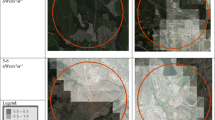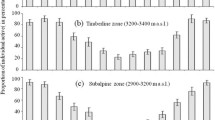Abstract
Despite the wealth of knowledge available on the ecology, biology and physiology of the Ectemnorhinus group of weevils, little is known about the determinants of their activity patterns. Here we investigated the relationship between the activity of Bothrometopus brevis (C.O. Waterhouse) and wind direction and strength, precipitation, cloud cover, temperature, relative humidity, and habitat moisture status, on Heard Island. B. brevis was most active during warm, north-wind and light rain conditions or when it was not raining, but its habitat was wet. During heavy precipitation, activity was low, and it was negligible during cold, south-wind conditions, especially during rain or snow. There was a clear relationship between activity and early frontal conditions, which also appears to be consistent across weevil species on Heard and Marion islands. The importance of frontal rain for activity suggests that any change to frontal movement across the islands might have pronounced impacts on weevil activity.



Similar content being viewed by others
References
Allison IF, Keage PL (1986) Recent changes in the glaciers of Heard Island. Polar Rec 23:255–271
Anonymous (1994) Heard Island Wilderness Reserve. Management plan. Australian Antarctic Division, Hobart
Barendse J, Chown SL (2001) Abundance and seasonality of mid-altitude fellfield arthropods from Marion Island. Polar Biol 24:73–82
Barendse J, Chown SL (2000) The biology of Bothrometopus elongatus (Coleoptera, Curculionidae) in a mid-altitude fellfield on sub-Antarctic Marion Island. Polar Biol 23:346–351
Chown SL (1989) Habitat use and diet as biogeographic indicators for subantarctic Ectemnorhinini (Coleoptera: Curculionidae). Antarct Sci 1:23–30
Chown SL (1993a) Desiccation resistance in six sub-Antarctic weevils (Coleoptera: Curculionidae): humidity as an abiotic factor influencing assemblage structure. Funct Ecol 7:318–325
Chown SL (1993b) Instar number and mass of Palirhoeus eatoni (C.O. Waterhouse) and Bothrometopus randi Jeannel (Coleoptera: Curculionidae) from Sub-Antarctic Marion Island. Coleopt Bull 47:69–73
Chown SL (1994) Historical ecology of sub-Antarctic weevils (Coleoptera: Curculionidae): patterns and processes on isolated islands. J Nat Hist 28:411–433
Chown SL, Klok CJ (2001) Habitat use, diet and body size of Heard Island weevils. Polar Biol 24:706–712
Chown SL, Klok CJ (2003) Altitudinal body size clines: latitudinal effects associated with changing seasonality. Ecography 26:445–455
Chown SL, Scholtz CH (1989) Biology and ecology of the Dusmoecetes Jeannel (Col. Curculionidae) species complex on Marion Island. Oecologia 80:93–99
Chown SL, Smith VR (1993) Climate change and the short-term impact of feral house mice at the sub-Antarctic Prince Edward Islands. Oecologia 96:508–516
Crafford JE (1990) The role of feral house mice in ecosystem functioning on Marion Island. In: Kerry KR, Hempel G (eds) Antarctic ecosystems. Ecological change and conservation. Springer, Berlin Heidelberg New York, pp 359–364
Crafford JE, Chown SL (1991) Comparative nutritional ecology of bryophyte and angiosperm feeders in a sub-Antarctic weevil species complex (Coleoptera: Curculionidae). Ecol Entomol 16:323–329
Dobson AJ (2002) An introduction to generalized linear models. Texts in statistical science. Chapman and Hall/CRC, Boca Raton, Fla.
Dreux P, Voisin JF (1978) Notes sur le genre Dusmoecetes et description de D. tamarisi n. sp. Bull Soc Entomol Fr 83:29–36
Ernsting G, Block W, MacAlister H, Todd C (1995) The invasion of the carnivorous carabid beetle Trechisibus antarcticus on South Georgia (sub-Antarctic) and its effect on the endemic herbivorous beetle Hydromedion spasutum. Oecologia 103:34–42
Ernsting G, Brandjes GJ, Block W, Isaaks JA (1999) Life-history consequences of predation for a subantarctic beetle: evaluating the contribution of direct and indirect effects. J Anim Ecol 68:741–752
Green K (2000) Coastal studies at Heard Island 1992/93: Changes in sea surface temperature and coastal landforms. Pap Proc R Soc Tasmania 133:27–32
Gressit JL, Temple P (1970) Introduction to Heard Island. Pac Insects Monogr 23:17–30
Klok CJ, Chown SL (2003) Resistance to temperature extremes in sub-Antarctic weevils: interspecific variation, population differentiation and acclimation. Biol J Linn Soc 78:401–414
Kuschel G (1970) Coleoptera: Curculionidae of Heard Island. Pac Insects Monogr 23:255–260
Kuschel G (1971) Curculionidae. In: Van Zinderen Bakker EM, Winterbottom JM, Dyer RA (eds) Marion and Prince Edward Islands. Report on the South African Biological and Geological Expedition 1965–1966. Balkema, Cape Town, pp 355–359
Le Roux V, Chapuis JL, Frenot Y, Vernon P (2002) Diet of the house mouse (Mus musculus) on Guillou Island, Kergeulen archipelago, Subantarctic. Polar Biol 25:49–57
Malcolm SB (1992) Prey defence and predator foraging. In: Crawley MJ (ed) Natural enemies: the population biology of predators, parasites and diseases. Blackwell, Oxford, pp 458–475
McCullagh P, Nelder JA (1989) Generalized linear models. Chapman and Hall, London
Ottesen PS (1990) Diel activity patterns of Carabidae, Staphylinidae and Perimylopidae (Coleoptera) at South Georgia, Sub-Antarctic. Polar Biol 10:515–519
Sih A, Harding KC (2000) New insights on how temporal variation in predation risk shapes prey behaviour. Trends Ecol Evol 15:3–4
Smith VR, Steenkamp M (1990) Climatic change and its ecological implications at a subantarctic island. Oecologia 85:14–24
Smith VR, Steenkamp M (1992a) Macroinvertebrates and litter nutrient release on a sub-Antarctic island. S Afr J Bot 58:105–116
Smith VR, Steenkamp M (1992b) Soil macrofauna and nitrogen on a sub-Antarctic island. Oecologia 92:201–206
Smith VR, Avenant NL, Chown SL (2002) The diet of house mice on a sub-Antarctic island. Polar Biol 25:703–715
Thost D, Allison I (2003) The climate of Heard Island. In: Green K, Woehler EJ (eds) Heard Island. A biogeographic isolate. Surrey and Beatty, Chipping Norton
Voisin J (1976) Sur le genre Bothrometopus Jeannel 1940. Bull Soc Entomol Fr 81:9–16
Voisin J-F, Dreux P (1987) Les peuplements de Coléoptères des Terres subantarctiques de l’Océan Indien. Bull Soc Zool Fr 112:455–470
Acknowledgements
Dana Bergstrom and Kate Kiefer assisted in Australia and at Heard Island, and Andrew Lock, Dale Main, and Karl Rollings provided support in the field at Heard Island. Valdon Smith loaned us the thermohygrometer. Three anonymous referees are thanked for their comments. This work was supported by the Australian Antarctic Division (ASAC Project No. 1191) and by the South African National Antarctic Programme (Department of Environmental Affairs and Tourism). The USAID Capacity Building Programme for Climate Change Research provided additional support to S.L.C. This is a contribution to the SCAR RiSCC programme.
Author information
Authors and Affiliations
Corresponding author
Rights and permissions
About this article
Cite this article
Chown, S.L., Klok, C.J. & McGeoch, M.A. Weather to go out: activity of Bothrometopus brevis (Curculionidae) at Heard Island. Polar Biol 27, 217–221 (2004). https://doi.org/10.1007/s00300-003-0579-8
Received:
Accepted:
Published:
Issue Date:
DOI: https://doi.org/10.1007/s00300-003-0579-8




